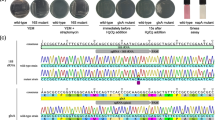Abstract
A novel method for the genetic transformation of cotton pollen by means of vacuum infiltration and Agrobacterium-mediated transformation is reported. The acsA and acsB genes, which are involved in cellulose synthesis in Acetobacter xylinum, were transferred into pollen grains of brown cotton with the aim of improving its fiber quality by incorporating useful prokaryotic features into the colored cotton plants. Transformation was carried out in cotton pollen-germinating medium, and transformation was mediated by vector pCAMBIA1301, which contains a reporter gene β-glucuronidase (GUS), a selectable marker gene, hpt, for hygromycin resistance and the genes of interest, acsA and acsB. The integration and expression of acsA, acsB and GUS in the genome of transgenic plants were analyzed with Southern blot hybridization, PCR, histochemical GUS assay and Northern blot hybridization. We found that following pollination on the cotton stigma transformed pollen retained its capability of double-fertilization and that normal cotton seeds were produced in the cotton ovary. Of 1,039 seeds from 312 bolls pollinated with transformed pollen grains, 17 were able to germinate and grow into seedlings for more than 3 weeks in a nutrient medium containing 50 mg/l hygromycin; eight of these were transgenic plants integrated with acsA and acsB, yielding a 0.77% transformation rate. Fiber strength and length from the most positive transformants was 15% greater than those of the control (non-transformed), a significant difference, as was cellulose content between the transformed and control plants. Our study suggests that transformation through vacuum infiltration and Agrobacterium mediated transformation can be an efficient way to introduce foreign genes into the cotton pollen grain and that cotton fiber quality can be improved with the incorporation of the prokaryotic genes acsA and acsB.





Similar content being viewed by others
References
Bayley C, Trolinder N, Ray C, Morgan M, Quisenberry JE, Ow DW (1992) Engineering 2,4-D resistance into cotton. Theor Appl Genet 83:645–649
Bechtold N, Bouchez D (1995) In planta Agrobacterium-mediated gene transfer by infiltration. In: Potrykus I, Spangenberg G (eds) Gene transfer to plants, vol 1. Springer, Berlin Heidelberg New York, pp 19–23
Bechtold N, Ellis J, Pelletier G (1993) In planta Agrobacterium-mediated gene transfer by infiltration of adult Arabidopsis thaliana plants. CR Acad Sci Paris Life Sci 316:1194–1199
Chlan CA, Lin J, Cary JW, Cleveland TE (1995) A procedure for biolistic transformation and regeneration of transgenic cotton from merismatic tissue. Plant Mol Biol Rep 13:31–37
Delmer DP, Amor Y (1995) Cellulose biosynthesis. Plant Cell 7:987–1000
Firoozabady E, Deboer DL, Merlo DJ, Halk EL, Amerson LN, Rashka KE, Murray EE (1987) Transformation of cotton (Gossypium hirsutum L.) by Agrobacterium tumifaciens and regeneration of transgenic plants. Plant Mol Biol 10:105–116
Hobbs SLA, Warkentin TD, Delong CMO (1993) Transgene copy number can be positively or negatively associated with transgene expression. Plant Mol Biol 21:17–26
Jefferson RA (1987) Assaying chimeric genes in plants: the GUS gene fusion system. Plant Mol Biol Rep 5:387–405
John ME, Crow LJ (1992) Gene expression in cotton (Gossypium hirsutum L.) fiber: cloning of the mRNAs. Proc Natl Acad Sci USA 89:5769–5773
Lin FC, Brown RM Jr, Drake RR Jr, Haley BE (1990) Identification of the Uridine 5′-diphosphoglucose (UDP-glc) binding subunit of cellulose synthase in Acetobacter xylinmum using the photoaffinity probe 5-azido-UDP-gle. J Biol Chem 265:4782–4784
Murashige T, Skoog F (l962) A revised method for rapid growth and bioassays with tobacco tissue cultures. Physiol Plant 15:473–497
Murthy MSS (2001), Never say dye: the story of colored cotton. Resonance, December 29–35
Paterson AH, Brubaker CL, Wendel JF (1993) A rapid method for extraction of cotton (Gossypium spp.) genomic DNA suitable for RFLP or PCR analysis. Plant Mol Biol Rep 11:122–127
Perlak FJ, Deaton RW, Armstrong TA, Fuchs RL, Sims SR, Greenplate JT, Fishhoff DA (1990) Insect- resistant cotton plants. Biotechnology 8:939–943
Prols F, Meyer P (1992) The methylation patterns of chromosomal integration regions influence gene activity of transferred DNA in Petunia hybrida. Plant J 2:465–475
Saxena IM, Lin FC, Brown RM Jr (1990) Cloning and sequencing of the cellulose synthase catalytic subunit gene of Acetobacter xylinum. Plant Mol Biol 15:673–683
Saxena IM, Lin FC, Brown RM Jr (1991) Identification of a new gene in an operon for cellulose biosynthesis in Acetobacter xylinum. Plant Mol Biol 16:947–954
Saxena IM, Kudlica K, Brown RM Jr (1994) Characterization of genes in the cellulose-synthesizing operon (acs operon) of Acetobacter xylinum: implications for cellulose crystallization. J Bacteriol 176:5735–5752
Stelly DM, Altman DW, Kohel RJ, Rangan TS, Commiskey E (1985) Agro Abstracts, American Society of Agronomy, Madison, Wis., p 135
Tjokrokusumo D, Heinrich T, Wylie S (2000) Vacuum infiltration of Petunia hybrida pollen with Agrobacterium tumefaciens to achieve plant transformation. Plant Cell Rep 19:792–797
Umbeck P, Johnson G, Barton K, Swain W (1987) Genetically transformed cotton (Gossypium hirsutum L.) plants. Biotechnology 5:263–265
Wong HC, Fear AL, Calhoon RD, Eidhinger GH, Mayer R, Amikam D, Benziman M, Gelfand D H, Meade J H, Emerick AW, Bruner R, Ben-Basat BA, Aal R (1990) Genetic organization of the cellulose synthase operon in Acetobacter xylinum. Proc Natl Acad Sci USA 87:8130–8134
Author information
Authors and Affiliations
Corresponding author
Additional information
Communicated by D. Bartels
Rights and permissions
About this article
Cite this article
Li, X., Wang, X.D., Zhao, X. et al. Improvement of cotton fiber quality by transforming the acsA and acsB genes into Gossypium hirsutum L. by means of vacuum infiltration. Plant Cell Rep 22, 691–697 (2004). https://doi.org/10.1007/s00299-003-0751-1
Received:
Revised:
Accepted:
Published:
Issue Date:
DOI: https://doi.org/10.1007/s00299-003-0751-1




